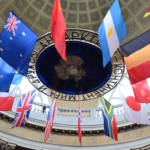Time zones are an essential part of the way we organize our daily lives, aligning our activities with the rise and fall of the sun. But did you know that some countries span multiple time zones due to their vast geographical expanse or overseas territories? In this blog post, we’ll explore which country has the most time zones, why this occurs, and how it affects global timekeeping.
The Concept of Time Zones: A Brief Overview
Before diving into the countries with the most time zones, it’s important to understand the concept of a time zone. A time zone is a region where the same standard time is used, typically based on the position of the sun. The Earth is divided into 24 main time zones, each representing an hour of the day. Time zones are based on longitudinal divisions, starting at the Prime Meridian in Greenwich, England (GMT or UTC).
Time zones are essential because the Earth’s rotation means that different parts of the world experience daylight at different times. As you move westward, time moves “backward” in terms of hours, and as you move eastward, it moves “forward.”
However, the division of time zones is not strictly based on geography. Politics, economics, and history have shaped how countries manage their time zones, and in many cases, this leads to countries having several time zones.
France: The Country with the Most Time Zones
Surprisingly, the country with the most time zones is not one of the largest by landmass. It’s France, boasting a total of 12 time zones. How does a country that is geographically smaller than Russia or Canada manage to hold this record? The answer lies in France’s numerous overseas territories, which are scattered across the globe.
France’s Overseas Territories
France’s overseas territories include places such as French Polynesia in the Pacific Ocean, French Guiana in South America, and Réunion in the Indian Ocean. Because these territories are spread over various parts of the globe, they observe different time zones. Here’s a look at some of the territories and their time zones:
- Metropolitan France (Europe): UTC+1 (Central European Time)
- Guadeloupe (Caribbean): UTC-4
- French Guiana (South America): UTC-3
- Réunion (Indian Ocean): UTC+4
- French Polynesia (Pacific Ocean): UTC-10
This wide geographical spread results in France covering 12 time zones, more than any other country.
Impact on Global Timekeeping
France’s dominance in the time zone count is largely symbolic in terms of global timekeeping. The country’s overseas territories are relatively small compared to other global players, so while France technically has the most time zones, its influence on global business and politics does not match the reach of other countries with vast mainland areas.
Russia: The Largest Landmass, the Second Most Time Zones
Russia, the world’s largest country by land area, comes in second with 11 time zones. Russia stretches across Eurasia from the westernmost part of Europe to the far eastern reaches of Asia, giving it an enormous geographical range.
Russia’s Time Zones
Russia spans a massive distance, with its westernmost point bordering Finland and its easternmost point reaching the Bering Strait, just a stone’s throw from Alaska. As a result, the country is divided into the following time zones, from west to east:
- Kaliningrad: UTC+2
- Moscow: UTC+3
- Samara: UTC+4
- Yekaterinburg: UTC+5
- Omsk: UTC+6
- Krasnoyarsk: UTC+7
- Irkutsk: UTC+8
- Yakutsk: UTC+9
- Vladivostok: UTC+10
- Magadan: UTC+11
- Kamchatka: UTC+12
Despite its vast size, Russia recently reduced the number of time zones from 11 to 9 in 2010 to streamline government operations. However, after public outcry and practical issues, the government restored the original 11 time zones in 2014.
How Russia’s Time Zones Affect Trade and Communication
Russia’s massive landmass and diverse time zones make it challenging for communication and trade within the country and with international partners. Businesses must carefully navigate the time differences between Moscow, the country’s political and financial hub, and other key cities like Vladivostok and Novosibirsk.
For international trade, especially with Europe and Asia, Russia’s spread across time zones can be both an advantage and a challenge. The ability to conduct business in different time zones can mean extended workdays, but it also requires careful coordination.
The United States: A Global Power with 11 Time Zones
Like France, the United States benefits from having overseas territories in addition to its large mainland, giving it a total of 11 time zones. The U.S. mainland is divided into six main time zones, with Alaska and Hawaii adding two more. When U.S. territories like Guam and Puerto Rico are considered, the count rises to 11.
Time Zones in the Continental U.S.
The continental U.S. spans four primary time zones from east to west:
- Eastern Standard Time (EST): UTC-5
- Central Standard Time (CST): UTC-6
- Mountain Standard Time (MST): UTC-7
- Pacific Standard Time (PST): UTC-8
Additional time zones include Alaska (UTC-9) and Hawaii (UTC-10), with U.S. territories such as:
- Puerto Rico: UTC-4
- American Samoa: UTC-11
- Guam: UTC+10
This broad distribution of time zones allows the U.S. to have a significant presence in global affairs, both economically and politically.
Time Zone Challenges in the U.S.
For the United States, managing different time zones is an inherent challenge, particularly in sectors such as aviation, broadcasting, and government services. Scheduling meetings and coordinating across time zones can lead to confusion, particularly when factoring in daylight saving time, which is not uniformly observed in all states or territories.
Other Countries with Multiple Time Zones
Several other countries have multiple time zones due to their size or overseas territories. Here are a few notable examples:
- Canada: Canada has six time zones, from Newfoundland Time (UTC-3:30) in the east to Pacific Time (UTC-8) in the west.
- Australia: Australia has three main time zones across its mainland: Australian Eastern Time (UTC+10), Central Time (UTC+9:30), and Western Time (UTC+8). Additionally, external territories like the Cocos Islands add more time zones.
- Brazil: With four time zones, Brazil spans a wide area in South America, from UTC-5 in the western Amazon to UTC-3 in cities like São Paulo and Rio de Janeiro.
The Role of Time Zones in Modern Globalization
Time zones play a crucial role in today’s globalized world. They influence everything from international trade to communications, travel, and even diplomacy. With businesses operating across continents, understanding time zones is essential to managing operations and meetings efficiently. Additionally, as more people work remotely or across international borders, navigating time zones has become an everyday challenge for many.
Technological advances like scheduling tools, online calendars, and global communication platforms have made it easier to manage time zone differences, but they have not eliminated the complexities that arise from countries with multiple time zones.
Conclusion: More Than Just Numbers on the Clock
While France technically holds the title for the most time zones, largely due to its overseas territories, Russia and the United States are also significant players in global timekeeping due to their sheer size and international influence. Whether for trade, politics, or culture, the ability to navigate time zones remains a critical skill in the modern world.
As globalization continues, the concept of time zones will likely remain relevant, though technology may eventually mitigate some of the challenges they present. Whether we’re dealing with conference calls across continents or coordinating international flights, understanding time zones is key to making the world run smoothly.
In the end, time zones are more than just numbers on a clock—they are a reminder of the diversity and complexity of the world we live in.
The Impact of Daylight Saving Time (DST) on Time Zones
An additional factor that complicates global timekeeping is the implementation of Daylight Saving Time (DST). DST is a practice used by many countries where clocks are set forward by one hour during the warmer months to make better use of daylight. While the intention is to conserve energy and extend daylight hours, DST can introduce further complexity when managing multiple time zones, especially in countries where not all regions observe it.
For example, in the United States, most states follow DST, but Hawaii and most of Arizona do not. This discrepancy adds an extra layer of difficulty when coordinating national schedules or planning travel. Moreover, countries like France, Russia, and Canada, with territories spread across different hemispheres, face varying DST policies across regions, making global synchronization even more challenging. For businesses, global institutions, and travelers, tracking when DST begins and ends in different parts of the world requires careful planning.
Time Zones in the Age of Technology
With the rise of digitalization and globalization, the need for seamless timekeeping across time zones has become even more essential. Technology companies, financial markets, and multinational corporations increasingly rely on automated tools to manage time differences. Global stock markets, for instance, must coordinate trades across different time zones, often adjusting for daylight saving shifts as well. Scheduling software and online platforms like Zoom or Google Calendar allow users to plan meetings and events across multiple time zones without needing to do manual calculations.
However, even with these tools, human error remains a factor. Mistakes often occur when people fail to account for time zone differences or changes in DST. In a globally interconnected world, miscalculating time can result in missed meetings, delayed flights, or lost business opportunities. While technology has reduced these issues, it hasn’t completely eliminated them, making time zone literacy a necessary skill for professionals and global travelers alike.
The Future of Time Zones: A Unified Global Time?
There has been some discussion about whether the world should move toward a unified global time, similar to the way the internet has established “internet time.” Proponents argue that standardizing time globally—perhaps using Coordinated Universal Time (UTC) as the baseline—could simplify international collaboration, trade, and travel. In such a scenario, local times would still exist but may be less relevant for global communications, which would operate on a single, shared time format.
Critics, however, suggest that the cultural and practical implications of such a shift would make it difficult to implement. Time zones are deeply tied to local customs, lifestyles, and the natural rhythm of daylight. While the concept of a global time system is intriguing, its adoption could face significant resistance from those who value local timekeeping practices.
The Cultural Significance of Time Zones
Time zones are not just logistical tools; they often reflect the cultural and political boundaries of a country. In some instances, time zones have been used to assert independence or national identity. For example, India maintains its own time zone, India Standard Time (UTC+5:30), which sets it apart from neighboring countries like China (which uses UTC+8) and Pakistan (UTC+5). Similarly, Nepal uses a unique time zone, UTC+5:45, a decision influenced by national pride and the desire to distinguish itself from its neighbors.
These examples show that time zones can carry symbolic meaning, reinforcing national or regional identities. The creation or alteration of time zones can be politically charged, affecting everything from international relations to local traditions. In this way, timekeeping is not just a technical issue but also a cultural one, with deep significance for how people and nations perceive themselves in relation to the rest of the world.
Final Thoughts: Time Zones in a Changing World
Time zones, while essential to organizing our global society, reflect the complex and diverse nature of our planet. Countries with multiple time zones, such as France, Russia, and the United States, embody the geographical, political, and cultural forces that shape global timekeeping. As the world continues to evolve, so too will the ways we manage and adapt to time zones. Whether through advancements in technology or changes in daylight saving policies, global timekeeping will remain a dynamic and important aspect of international collaboration.



